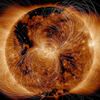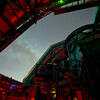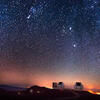You are here
Planet 9, do you copy?

Now that Pluto is no longer considered a true planet, the Solar System counts just eight such bodies. Or does it? What if there were a yet-undetected ninth planet lurking out there, well beyond the Kuiper Belt? Many astronomers believe this is the case, including Konstantin Batygin, at the California Institute of Technology (Caltech, United States) who, in 2016, with his colleague Michael Brown, announced they had discovered evidence of the gravitational influence of Planet 9 on the orbits of trans-Neptunian objects (i.e. whose orbits cross or lie beyond that of Neptune, Editor's note). However, these findings are the subject of considerable debate: some say the objects are too few in number, while the selection effects associated with the results of astronomical surveys may not have been properly taken into account. In a paper1 published last April, the researchers and their collaborators therefore turned their attention to a class of objects that are a priori less subject to observational bias. And they have come to the same conclusion, namely that their orbits can only be explained if they are under the influence of an as yet unknown planet.
A non-random distribution
Extreme trans-Neptunian objects are Solar System bodies with a perihelion (the point in their orbit closest to the Sun) at least 50 times the distance from the Earth to the Sun, and a highly elliptical trajectory. Their perihelia are therefore so distant that they go nowhere near Neptune, and are therefore hardly affected by the gravitational influence of the giant planets. Surprisingly, astronomical surveys carried out over several decades, during the 20th and early 21st century, have shown that the orbits of around ten of these objects appear to be aligned. "They all have the same orientation in the sky, so their distribution is not random," explains Sean Raymond of the LAB2.

However, the laws of celestial mechanics suggest that this should not be the case. When an object travels around the Sun, the axis of its orbit also wobbles, tracing out a path around our star, a phenomenon known as precession. "So, even if, over 4 billion years ago, a number of objects were ejected in the same direction due to perturbations in the early Solar System, their orbits should have diverged since then because of these precessions," says Alessandro Morbidelli, an astronomer and planetary scientist at the JL Lagrange laboratory3 and a professor at the Collège de France. The fact that the orbits have remained aligned all this time is a sign that there is “something” forcing them to behave differently from what might otherwise be expected. "Since the objects are a long way from Neptune, its gravitational influence can't be forcing their orbits to remain clustered together. The only explanation for this anomaly is that there must be another planet," the astronomer explains.
Eliminating bias
This is how the hypothesis of an as yet undiscovered planet in the Solar System first arose, and its main features were outlined in a paper4 published in 2016: it was thought to have a mass five to seven times greater than the Earth, and be moving in a distant, elliptical and inclined orbit. However, this conclusion was rapidly greeted with much lively debate and a fair amount of scepticism. How can we be certain that the orbits really are aligned? And then, since these orbital alignments only apply to bodies with highly elliptical orbits that go nowhere near Neptune, their number is limited: a mere ten or so may not be enough to be statistically reliable. Moreover, the objects were discovered by many different people using a wide range of astronomical surveys. How can we be sure that all the biases underlying these observations were correctly modelled?
"It is very hard to detect distant bodies in certain regions of the sky, such as the Galactic plane, where there are lots of stars. If you don't see any trans-Neptunian objects passing through it, and you only draw conclusions from the objects you have actually observed, this introduces biases," Raymond explains. "Batygin's team is convinced that the alignment they see is inherent to the population of objects they have looked at, but this is not universally accepted in the scientific community."



Jean-Marc Petit, an astronomer at the Institut UTINAM5 has spent some time studying the observational biases associated with the objects included in the 2016 paper and the way in which they were dealt with. Although he too thinks that there may possibly be a clustering of orbits, he also believes that the probability of this being the case is much lower than Batygin and his collaborators suggest. "We're not saying that there is no Planet 9," he stresses, "but rather that the argument they're putting forward is not powerful enough." And according to Morbidelli, "that's a perfectly legitimate view".
An impossible absence
In a new paper, Batygin, Morbidelli, Brown and David Nesvorný (a planetary scientist at the US Southwest Research Institute in Texas) have tried a new approach. Rather than concentrating on distant objects that, because they have highly elliptical orbits and never go near Neptune are very difficult to observe, they have now shifted their focus towards a class of trans-Neptunian objects that cross the Blue Giant's orbit. "These objects pass relatively close to us and are bright, which makes them easier to study," Morbidelli points out. "Some of them are already known to us and their observational biases are more straightforward to model."
Moreover, these objects are highly unstable. As they cross the orbits of giant planets, they are scattered and their trajectories altered. As a result, they have a lifespan of only a few tens of millions of years. They are therefore continuously replenished by the population of true trans-Neptunian objects. "We compared a system with a Planet 9 and a system without one to find out at what rate this population of Neptune-crossing objects can be renewed," Morbidelli adds. "And we found that without Planet 9, this rate is too low, with not enough objects crossing Neptune's orbit. With Planet 9, on the other hand, our models reproduce observations much better." In other words, this new study, a priori less biased than the previous ones, also clearly concludes that there is a yet-undiscovered planet. "It's a very nice idea, and the result is pretty clear," says Raymond. "It's a very fine piece of work and I think they’re onto something,” agrees Petit.
So, does this confirm the existence of a ninth planet? "It's not that simple," Raymond points out. "In principle, there are fewer observational biases in this study, but it's really difficult to eliminate all of them. There's still a chance that some hidden ones remain." Petit cites some of these possible biases: "For example, the surveys they use are not specifically focused on trans-Neptunian objects. In addition, the size of the objects, which they don't take into consideration, may be a significant factor." Any observation is subject to errors and estimates that can be difficult to take into account. "That's why, even if there are good reasons to think that Planet 9 really is there, you should never believe that something exists until you actually find it," Raymond points out. "You have to look for it with an open mind."
And in their search for Planet 9, astronomers will soon be assisted by a major new telescope, the Vera C. Rubin Observatory, currently under construction in Chile and expected to be up and running by early 2025. "The advantage of the Vera Rubin is that it observes over half the sky every two or three days, with a depth that is certainly as good as the Hubble Space Observatory,", Raymond says. "It's specifically designed to find dark objects moving across the sky, like Planet 9. It's not 100% certain that the telescope will detect it even if it does exist, but if it doesn't spot it, it'll be difficult to go on believing the planet is there."
What if it isn't a planet?
The alignment of the orbits of certain objects has prompted some researchers to come up with alternative ideas. For them, this anomaly could be caused either by a huge disc of celestial bodies located in the outer reaches of the Solar System, or by a mini black hole. "These are pretty wild ideas," smiles Morbidelli. "I'd love someone to tell me how a black hole of 5 Earth masses could be formed." The same goes for the highly eccentric disc: if it is made up of a large number of celestial bodies, some of them should already have been spotted, due to the occultation of a star that occurs when one of them passes in front of it. But nothing like that has ever been seen. "On the other hand, the existence of a planet in the orbit believed to be that of Planet 9 would be quite normal given the process of formation of giant planets: as they grow larger, they eject planets of a few Earth masses outwards, where they can remain trapped in distant eccentric orbits," Morbidelli points out. So, if Planet 9 does exist, it is therefore most likely to be just that: a planet. ♦
Further reading on our website
Closing in on Planet 9
The ninth planet (column by Denis Guthleben, historian of science at the CNRS)
- 1. https://arxiv.org/abs/2404.11594
- 2. Laboratoire d’Astrophysique de Bordeaux (CNRS / Université de Bordeaux).
- 3. CNRS / Observatoire de la Côte d’Azur / Université Côte d’Azur.
- 4. https://iopscience.iop.org/article/10.3847/0004-6256/151/2/22
- 5. Univers, Théorie, Interfaces, Nanostructures, Atmosphère et environnement, Molécules (CNRS / Université de Franche-Comté).















